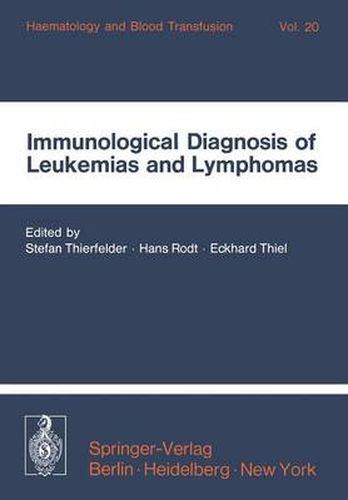Readings Newsletter
Become a Readings Member to make your shopping experience even easier.
Sign in or sign up for free!
You’re not far away from qualifying for FREE standard shipping within Australia
You’ve qualified for FREE standard shipping within Australia
The cart is loading…






This title is printed to order. This book may have been self-published. If so, we cannot guarantee the quality of the content. In the main most books will have gone through the editing process however some may not. We therefore suggest that you be aware of this before ordering this book. If in doubt check either the author or publisher’s details as we are unable to accept any returns unless they are faulty. Please contact us if you have any questions.
This two-and-a-half-day symposium has concentrated on main aspects of the rapidly expanding field ofleukocyte markers in hematology. While leukemias are already being ‘phenotyped’ routinely in clinical centers, continued research on the developmental sta ge of cells and cell membranes, expanding into a malignant clone, permits new snap shots on hemopoietic differentiation. Thus the discovery of leukemia-associated anti gens, which so far have not been found on subpopulations of normal cells, has greatly stimulated the discussion on ‘differentiation antigens versus tumor antigens’. The proceedings reflect the considerable success which has been achieved very re cently in the classification of hemoblastomas. Consequently the number of leukemias which are unclassifiable by immunological methods have dwindled down to a small mi nority. New facts give rise to new questions. By including the main points of the discussions in the proceedings, we wanted to give the reader an opportunity to get an impression of the questions and conclusions raised and drawn by the participants on the basis of new - and frequently still unpublished - data. The editors thank both the contributors to this symposium, who made it a successful meeting and submitted their manuscripts punctually, and the publishers, who have provided a volume of high quality in good time. They are also grateful for the valuable cooperation from numerous colleages at the Institut fUr Hamatologie.
$9.00 standard shipping within Australia
FREE standard shipping within Australia for orders over $100.00
Express & International shipping calculated at checkout
This title is printed to order. This book may have been self-published. If so, we cannot guarantee the quality of the content. In the main most books will have gone through the editing process however some may not. We therefore suggest that you be aware of this before ordering this book. If in doubt check either the author or publisher’s details as we are unable to accept any returns unless they are faulty. Please contact us if you have any questions.
This two-and-a-half-day symposium has concentrated on main aspects of the rapidly expanding field ofleukocyte markers in hematology. While leukemias are already being ‘phenotyped’ routinely in clinical centers, continued research on the developmental sta ge of cells and cell membranes, expanding into a malignant clone, permits new snap shots on hemopoietic differentiation. Thus the discovery of leukemia-associated anti gens, which so far have not been found on subpopulations of normal cells, has greatly stimulated the discussion on ‘differentiation antigens versus tumor antigens’. The proceedings reflect the considerable success which has been achieved very re cently in the classification of hemoblastomas. Consequently the number of leukemias which are unclassifiable by immunological methods have dwindled down to a small mi nority. New facts give rise to new questions. By including the main points of the discussions in the proceedings, we wanted to give the reader an opportunity to get an impression of the questions and conclusions raised and drawn by the participants on the basis of new - and frequently still unpublished - data. The editors thank both the contributors to this symposium, who made it a successful meeting and submitted their manuscripts punctually, and the publishers, who have provided a volume of high quality in good time. They are also grateful for the valuable cooperation from numerous colleages at the Institut fUr Hamatologie.